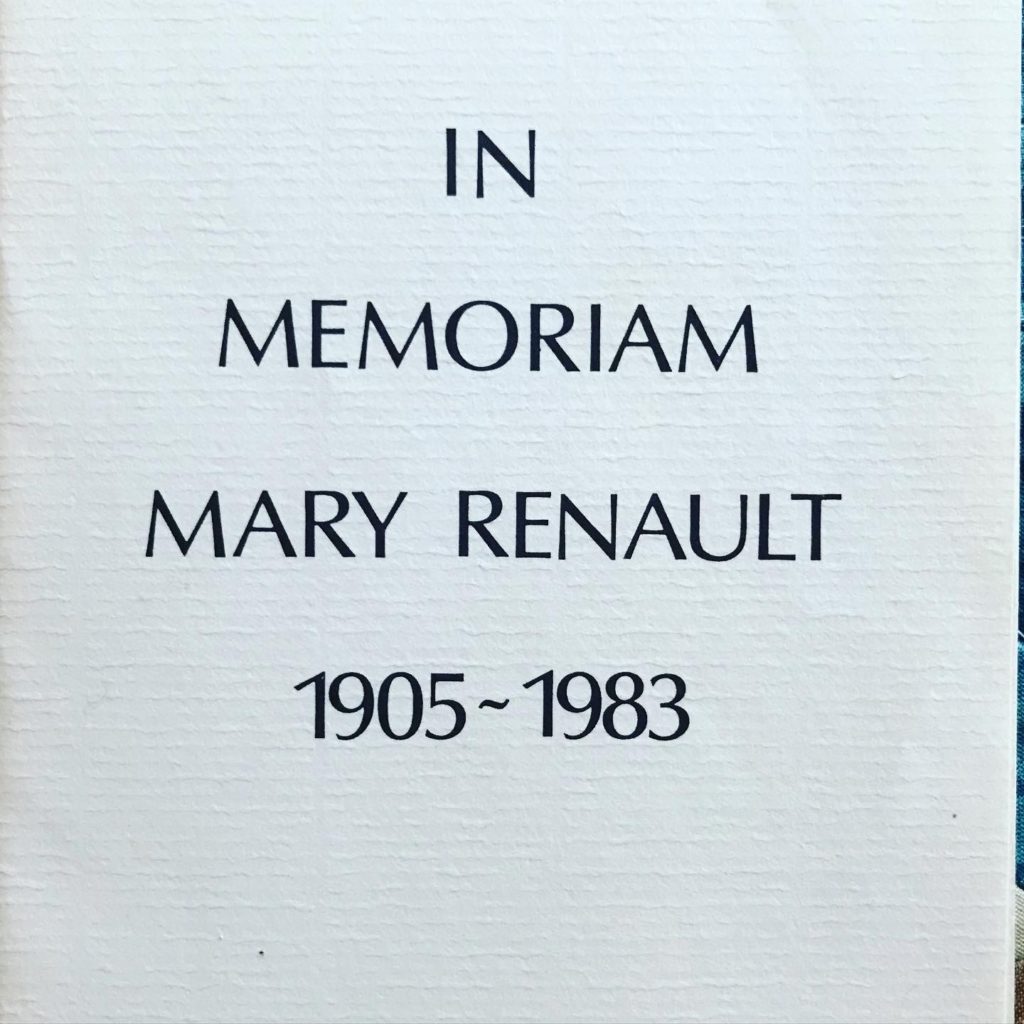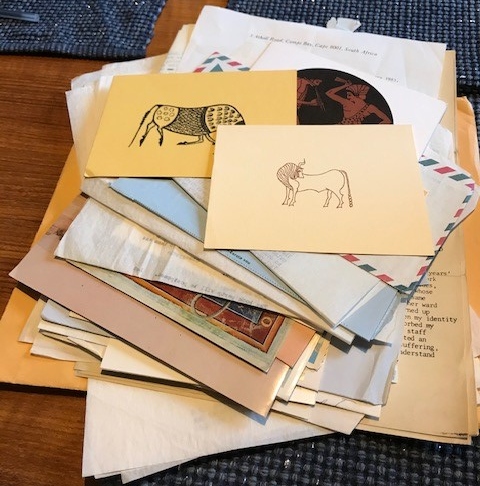Mary Renault (1905-1983) was a highly influential author of novels featuring gay, lesbian, and bisexual characters—many written during a time period in which queer people faced extreme legal and social pressures. Born in England, she attended St Hugh’s College, Oxford, gaining (like Auden, her contemporary) a third in English, before training to become a nurse. Her first novel Purposes of Love (Promise of Love in the USA), a hospital romance about a bixsexual love-triangle, was published in 1939 by Longmans, Green & Co. She won the $150,000 (£37,000) MGM Award for her novel Return to Night (1947), after which she and her partner, Julie Mullard, moved to South Africa. Then followed her ground-breaking novel The Charioteer (1953), which tells the story of a wounded WWII soldier who falls in love with a conscientious objector. But it was in The Last of the Wine (1956) that Renault discovered the setting with which she would become most closely associated. Set in Ancient Greece, the novel follows two lovers, Alexias and Lysis, during the political upheavals at the end of the Peloponnesian War. The historical Grecian setting—where all her remaining novels were set—allowed her to write queer characters who no longer faced social or political opprobrium for their relationships. Meticulously researched, her work reached a broad international readership, and were popular selections for the Book of the Month Club (USA) and the Book Society (UK). Longmans printed 50,000 copies of her novel The King Must Die (1958)—the film rights of which were sold to Twentieth Century Fox for $75,000.

Despite her international popularity, Renault has remained an understudied figure. Two biographies, Mary Renault: A Biography (1993) by David Sweetman and The Masks of Mary Renault: A Literary Biography by Caroline Zilboorg (2001) have been published, but other scholarly works have been (relatively) scarce (see below for a reading list). Researchers are hampered by the fact that at Renault’s instruction, her correspondence—including ‘thousands and thousands’ of letters to and from fans from across the world—was burnt after her death, along with the manuscript of her unfinished final book. Though a prolific correspondent, the destruction of her archive means that remaining examples of her letters are relatively rare outside the Longmans archive at the University of Reading (Renault had opinions about her novels, and was not afraid to tell her publishers so).
Recently, however, a tranche of correspondence has come back to light and will shortly be available to researchers.
One of only two people to write a book-length analysis of Renault’s work is Bernard Dick, Professor Emeritus of English and Communications at Farleigh Dickinson University (New Jersey, USA), with his work The Hellenism of Mary Renault (1972). In 1969, Dick began to correspond with Renault, asking her about her work and her motivations for writing. As I prepared to write a thesis chapter on Renault and her publishing history, I was pleasantly surprised to discover that Dick was still contactable and had retained his correspondence with Renault. In a very generous act, Dick sent me his full archive of Renault correspondence, including some 40 letters, postcards, Christmas cards, and the ‘In Memorium’ card Mullard sent to friends and acquaintances after Renault’s death in December 1983.

The letters, typewritten on airmail envelopes (Renault, by her own admission, had terrible handwriting) or on thin sheets of paper, cover the period 1969-1983. They discuss her motivations for writing her novels, comments on specific novels—her novel The Friendly Young Ladies (1944) was inspired by reading, and laughing at, The Well of Loneliness—her thoughts on Peter Wolfe’s Mary Renault (1969), and her fraught relationship with American film producers who had bought the rights to Fire From Heaven (1969) and The Persian Boy (1972).
Bernard Dick requested that after I finished using the letters, the material should be donated to the St Hugh’s College, Oxford archive. The archive already contains photocopies of letters from Renault to various correspondents (including the writer Colin Spencer and the publisher Helen Wolff), as well as a lengthy transcription of a series of interviews with Mullard, materials that were donated by Sweetman and Zilboorg.
The St Hugh’s College Archivist, Amanda Ingram, has catalogued the collection, and it is now available to researchers.
Did you correspond with Mary Renault? Get in touch!
Christopher Adams (Christopher.Adams1@postgrad.sas.ac.uk) is an LAHP-funded PhD student at the Institute of English Studies, School of Advanced Study, University of London. You can find him on Twitter @beijingcoma or Instagram @queer_books
Further reading:
Julie Abraham, Are Girls Necessary?: Lesbian Writing and Modern Histories (Minneapolis: University of Minnesota Press, 2008 [1996])
Bernard F. Dick, The Hellenism of Mary Renault (Carbondale: Southern Illinois University Press, 1972)
Martin Dines, ‘“Is it a queer book?” Re-Reading the 1950s Homosexual Novel’, in The 1950s: A Decade of Modern British Fiction ed by Nick Bentley and others (London: Bloomsbury, 2018)
Jesi Egan, ‘Cultural Futurity and the Politics of Recovery: Mary Renault’s Ambivalent Romances’ in Modern Fiction Studies, vol. 62 no. 3, 2016
Nikolai Endres, ‘Horses and Heroes: Plato’s “Phaedrus” and Mary Renault’s “The Charioteer”’, International Journal of the Classical Tradition 19, no. 3, 2012
Lisa Lynne Moore. ‘Lesbian Migrations: Mary Renault’s South Africa’ GLQ: A Journal of Lesbian and Gay Studies, vol. 10 no. 1, 2003
Natalie Nobitz, History’s Queer Stories (Bielefeld: Transcript-Verlag, 2018)
David Sweetman, Mary Renault: A Biography (London: Chatto & Windus, 1993)
Peter Wolfe, Mary Renault (New York: Twayne, 1969)
Caroline Zilboorg, The Masks of Mary Renault: A Literary Biography (Columbia: University of Missouri Press, 2001)

